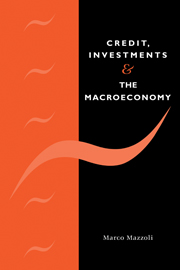Book contents
- Frontmatter
- Contents
- Preface and acknowledgements
- 1 Introduction
- Part I Banks, credit and the macroeconomy: a puzzle
- Part II Interactions between credit and industry: firms' market power and banks' liquidity preference
- Part III ‘Inside-the-firm’ interactions between finance and investments
- 6 Investments with firm-specific financial costs and ‘transaction’ of adjustment costs
- 7 Are investments and financial structure two faces of the same decision? A qualitative approach
- Summing up …
- Bibliography
- Index
6 - Investments with firm-specific financial costs and ‘transaction’ of adjustment costs
from Part III - ‘Inside-the-firm’ interactions between finance and investments
Published online by Cambridge University Press: 03 February 2010
- Frontmatter
- Contents
- Preface and acknowledgements
- 1 Introduction
- Part I Banks, credit and the macroeconomy: a puzzle
- Part II Interactions between credit and industry: firms' market power and banks' liquidity preference
- Part III ‘Inside-the-firm’ interactions between finance and investments
- 6 Investments with firm-specific financial costs and ‘transaction’ of adjustment costs
- 7 Are investments and financial structure two faces of the same decision? A qualitative approach
- Summing up …
- Bibliography
- Index
Summary
Introduction
Most empirical analyses on firms' investment decisions are based on small samples of firms issuing shares on the stock market. This is because in the empirical implementation of Tobin's q model it has become customary to use stock market data. This custom might become problematic when dealing with investment functions referring to firms operating in ‘non-securitized’ financial systems, in industrial sectors where the investment decision, and its modifications, might assume a strategic value, or in the presence of relevant transactions costs.
As pointed out in chapter 3, ‘non-securitized’ financial systems are characterized by the fact that the amount of finance raised on the stock market is negligible compared to volume of financial funds intermediated by the banking sector. An important role is played by agents competing in the activity of monitoring and collecting private information (the banks), while the stock market plays only a marginal role. Since many theoretical and empirical works have shown that the stock market plays an important role as a major vehicle of information, allowing firms to reduce the cost of monitoring supported by financial intermediaries, the fact of operating in a securitized or in a ‘non-securitized’ financial system might carry very relevant qualitative implications for the investment behaviour of a firm. In particular, in an institutional context where financial markets are less developed, we could expect the speed of adjustment of investments to be affected by relevant transaction costs.
- Type
- Chapter
- Information
- Credit, Investments and the MacroeconomyA Few Open Issues, pp. 135 - 163Publisher: Cambridge University PressPrint publication year: 1998



